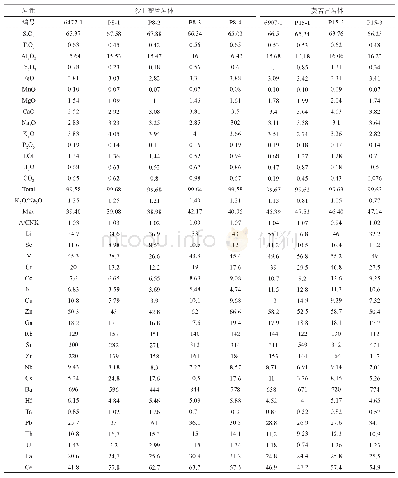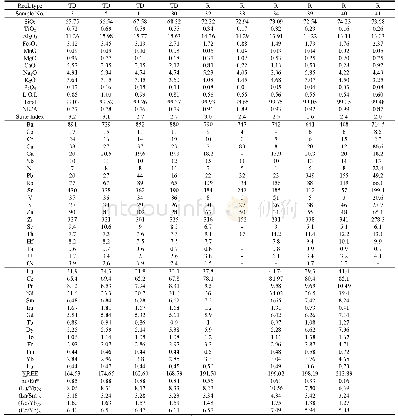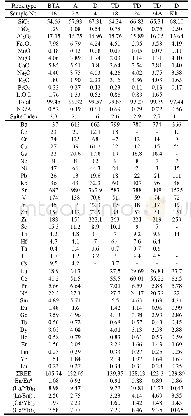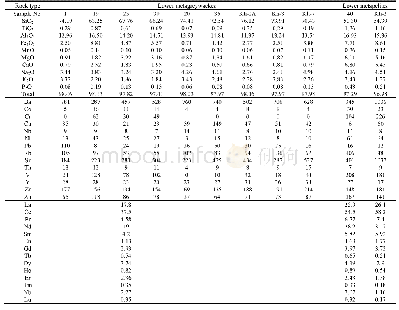《Table 3 major (wt%) , trace element (ppm) analyzing results of the plagiogranites, pillow basalts a
 提示:宽带有限、当前游客访问压缩模式
提示:宽带有限、当前游客访问压缩模式
本系列图表出处文件名:随高清版一同展现
《"Discovery of the Plagiogranites in the Diyanmiao Ophiolite, Southeastern Central Asian Orogenic Belt, Inner Mongolia, China and Its Tectonic Significance"》
The formation environment/mechanisms and source(s)of silicic rocks determine their spatial occurrence and geochemical characteristics(Li Xianwu and Li Xianhua,2003;Li and Li,2003;Koepke et al.,2004,2007;Yoshikawa and Ozawa,2007;Skjerlie et al.,2000;Whitehead et al.,2000;Freund et al.,2014).The Diyanmiao plagiogranites occur in the upper pillow basalts of the ophiolite sequence as irregular veins and small-scale bodies,which is consistent with the field occurrence of fractionation-type plagiogranites,and contrasts with the occurrence of shearing-,subduction-,and obduction-type plagiogranites.In addition,plagiogranites in the Diyanmiao ophiolite are characterized by relatively low Al2O3(11.9–13.30wt%)concentrations that are comparable with fractionation-and shearing-type plagiogranites(Al2O3<15wt%)(Pedersen and Malpas,1984;Flagler and Spray,1991;Li Xianwu and Li Xianhua,2003;Gao Xiao Feng et al.,2011) and different from subduction-type(Al2O3>15wt%)and obduction-type plagiogranites(highly variable Al2O3).Plagiogranites in the Diyanmiao ophiolite are also characterized by high Na2O(4.52–6.06wt%),very low K2O(0.03–0.07wt%),and high Na2O/K2O ratios(average=105.3)that are similar to fractionation-type plagiogranites(Na2O/K2O>3–5)and higher than shearingtype plagiogranites(Na2O/K2O>1)(Pedersen and Malpas,1984;Flagler and Spray,1991;Li and Li,2003;Gao et al.,2011) .These rocks have low∑REE(23.62–39.77 ppm),small negative Eu anomalies(δEu=0.44–0.62),and flat chondrite-normalized REE patterns( (La/Yb)N=0.68–0.76;Fig.6a) ,similar to fractionation-type plagiogranites and slightly different from shearing-type plagiogranites(minor light REE enrichment with a wide range ofδEu)and distinctly different from subductiontype(light REE enriched and heavy REE depleted)and obduction-type plagiogranites(LREE enriched)(Fig.6c)(Pedersen and Malpas,1984;Flagler and Spray,1991;Li and Li,2003;Gao Xiao Feng et al.,2011).Primitivemantle-normalized trace element patterns of the Diyanmiao plagiogranites have overall flat patterns(Fig.6b)with obvious P and Ti anomalies,consistent with fractionation-type plagiogranites(Fig.6d),but are slightly different from shearing-type plagiogranites(gently rightdipping patterns),and clearly distinct from subductiontype(marked Sr anomaly and steeply right-dipping patterns)and obduction-type plagiogranites(highly variable right-dipping patterns)(Fig.6d) .The chondritenormalized REE patterns of the plagiogranites are similar to those of the gabbros and pillow basalts(Table 3;Fig.6a).The REE concentrations increase from the gabbros to the pillow basalts and to the plagiogranites(Fig.6a),which is consistent with progressive fractional crystallization and differentiation.The plagiogranites have complementary Eu anomalies to the gabbros(Fig.6a),which can be interpreted as reflecting magma crystallization resulting in the formation of gabbros with positive Eu anomalies and a residual melt with negative Eu anomalies(Tang et al.,2007).
| 图表编号 | XD0017170600 严禁用于非法目的 |
|---|---|
| 绘制时间 | 2018.04.01 |
| 作者 | LI Yingjie、WANG Jinfang、WANG Genhou、DONG Peipei、LI Hongyang、HU Xiaojia |
| 绘制单位 | School of Nature Resources, Hebei GEO University、School of Nature Resources, Hebei GEO University、School of the Earth Sciences and Resources, China University of Geosciences、School of Nature Resources, Hebei GEO University、School of Nature Resources, Hebe |
| 更多格式 | 高清、无水印(增值服务) |
查看“Table 3 major (wt%) , trace element (ppm) analyzing results of the plagiogranites, pillow basalts and gabbros in the Diy”的人还看了
-

- 表3 花岗闪长岩主量元素的质量百分含量 (%) 和微量元素 (×10-6) 分析结果Major (wt.%) and trace elements (×10-6) data of granodiorite
-

- 表3 花岗闪长岩主量元素的质量百分含量 (%) 和微量元素 (×10-6) 分析结果Major (wt.%) and trace elements (×10-6) data of granodiorite


![Table 3:Tolerances (wt.%) for trace elements suggested by Gundlach of Element Materials Technology Wixom[13]](http://bookimg.mtoou.info/tubiao/gif/ZZAF201902001_08100.gif)


